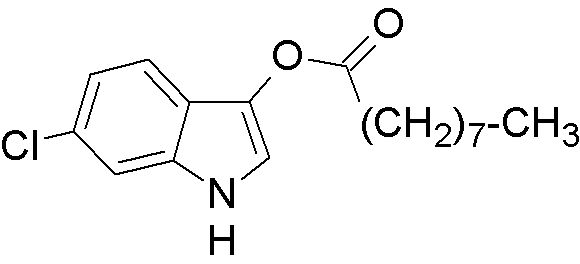6-Chloro-3-indoxyl nonanoate is widely utilized in research focused on:
- Biotechnology: This compound serves as a substrate for enzyme assays, particularly in the study of β-glucosidases, allowing researchers to measure enzyme activity effectively.
- Plant Research: It is used in plant tissue culture to monitor gene expression and study metabolic pathways, providing insights into plant development and responses to environmental stress.
- Pharmaceutical Development: The compound is explored for its potential in drug formulation, particularly in developing targeted therapies due to its unique chemical properties that enhance bioavailability.
- Colorimetric Assays: It is employed in colorimetric assays for detecting specific enzymes, offering a simple and visual method for quantifying biological activity in various samples.
- Environmental Monitoring: The compound can be utilized in assessing soil and water quality by detecting specific microbial activities, contributing to environmental sustainability efforts.
General Information
Properties
Safety and Regulations
Applications
6-Chloro-3-indoxyl nonanoate is widely utilized in research focused on:
- Biotechnology: This compound serves as a substrate for enzyme assays, particularly in the study of β-glucosidases, allowing researchers to measure enzyme activity effectively.
- Plant Research: It is used in plant tissue culture to monitor gene expression and study metabolic pathways, providing insights into plant development and responses to environmental stress.
- Pharmaceutical Development: The compound is explored for its potential in drug formulation, particularly in developing targeted therapies due to its unique chemical properties that enhance bioavailability.
- Colorimetric Assays: It is employed in colorimetric assays for detecting specific enzymes, offering a simple and visual method for quantifying biological activity in various samples.
- Environmental Monitoring: The compound can be utilized in assessing soil and water quality by detecting specific microbial activities, contributing to environmental sustainability efforts.
Documents
Safety Data Sheets (SDS)
The SDS provides comprehensive safety information on handling, storage, and disposal of the product.
Product Specification (PS)
The PS provides a comprehensive breakdown of the product’s properties, including chemical composition, physical state, purity, and storage requirements. It also details acceptable quality ranges and the product's intended applications.
Certificates of Analysis (COA)
Search for Certificates of Analysis (COA) by entering the products Lot Number. Lot and Batch Numbers can be found on a product’s label following the words ‘Lot’ or ‘Batch’.
*Catalog Number
*Lot Number
Certificates Of Origin (COO)
This COO confirms the country where the product was manufactured, and also details the materials and components used in it and whether it is derived from natural, synthetic, or other specific sources. This certificate may be required for customs, trade, and regulatory compliance.
*Catalog Number
*Lot Number
Safety Data Sheets (SDS)
The SDS provides comprehensive safety information on handling, storage, and disposal of the product.
DownloadProduct Specification (PS)
The PS provides a comprehensive breakdown of the product’s properties, including chemical composition, physical state, purity, and storage requirements. It also details acceptable quality ranges and the product's intended applications.
DownloadCertificates of Analysis (COA)
Search for Certificates of Analysis (COA) by entering the products Lot Number. Lot and Batch Numbers can be found on a product’s label following the words ‘Lot’ or ‘Batch’.
*Catalog Number
*Lot Number
Certificates Of Origin (COO)
This COO confirms the country where the product was manufactured, and also details the materials and components used in it and whether it is derived from natural, synthetic, or other specific sources. This certificate may be required for customs, trade, and regulatory compliance.


